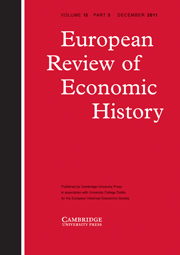Crossref Citations
This article has been cited by the following publications. This list is generated based on data provided by
Crossref.
Voth, Hans-Joachim
Horell, Sara
and
Humphries, Jane
2001.
Destined for Deprivation? Intergenerational Poverty Traps in Eighteenth-Century Britain.
SSRN Electronic Journal ,
Horrell, Sara
Humphries, Jane
and
Voth, Hans-Joachim
2001.
Destined for Deprivation: Human Capital Formation and Intergenerational Poverty in Nineteenth-Century England.
Explorations in Economic History,
Vol. 38,
Issue. 3,
p.
339.
Lindert, Peter H.
2004.
Growing Public.
Lindert, Peter H.
2004.
Growing Public.
Somers, Margaret R.
and
Block, Fred
2005.
From Poverty to Perversity: Ideas, Markets, and Institutions over 200 Years of Welfare Debate.
American Sociological Review,
Vol. 70,
Issue. 2,
p.
260.
Patriquin, Larry
2006.
Why was there no ‘Old Poor Law’ in Scotland and Ireland?.
Journal of Peasant Studies,
Vol. 33,
Issue. 2,
p.
219.
Komlos, John
2007.
Vol. 25,
Issue. ,
p.
149.
Boyer, George R.
2008.
The New Palgrave Dictionary of Economics.
p.
1.
Kelly, Morgan
and
O'Grada, Cormac
2009.
The Poor Law of Old England: Resource Constraints and Demographic Regimes.
SSRN Electronic Journal,
Boyer, George R.
2009.
Human Capital and Institutions.
p.
46.
DE MOOR, TINE
and
VAN ZANDEN, JAN LUITEN
2010.
Girl power: the European marriage pattern and labour markets in the North Sea region in the late medieval and early modern period1.
The Economic History Review,
Vol. 63,
Issue. 1,
p.
1.
Kelly, Morgan
and
O'Grada, Cormac
2010.
Living Standards and Mortality Since the Middle Ages.
SSRN Electronic Journal,
VAN LEEUWEN, MARCO H. D.
2012.
Giving in early modern history: philanthropy in Amsterdam in the Golden Age.
Continuity and Change,
Vol. 27,
Issue. 2,
p.
301.
VAN NEDERVEEN MEERKERK, ELISE
2012.
The will to give: charitable bequests, inter vivos gifts and community building in the Dutch Republic, c. 1600–1800.
Continuity and Change,
Vol. 27,
Issue. 2,
p.
241.
VAN VOSS, LEX HEERMA
and
VAN LEEUWEN, MARCO H. D.
2012.
Charity in the Dutch Republic: an introduction.
Continuity and Change,
Vol. 27,
Issue. 2,
p.
175.
TEEUWEN, DANIËLLE
2012.
Collections for the poor: monetary charitable donations in Dutch towns, c. 1600–1800.
Continuity and Change,
Vol. 27,
Issue. 2,
p.
271.
2013.
Escaping poverty.
p.
439.
Lindert, Peter H.
2014.
The Cambridge History of Capitalism.
p.
464.
van Nederveen Meerkerk, E.
and
Teeuwen, D.
2014.
The stability of voluntarism: financing social care in early modern Dutch towns compared with the English Poor Law, c. 1600-1800.
European Review of Economic History,
Vol. 18,
Issue. 1,
p.
82.
Kelly, Morgan
and
Ó Gráda, Cormac
2014.
Living standards and mortality since the middle ages.
The Economic History Review,
Vol. 67,
Issue. 2,
p.
358.


